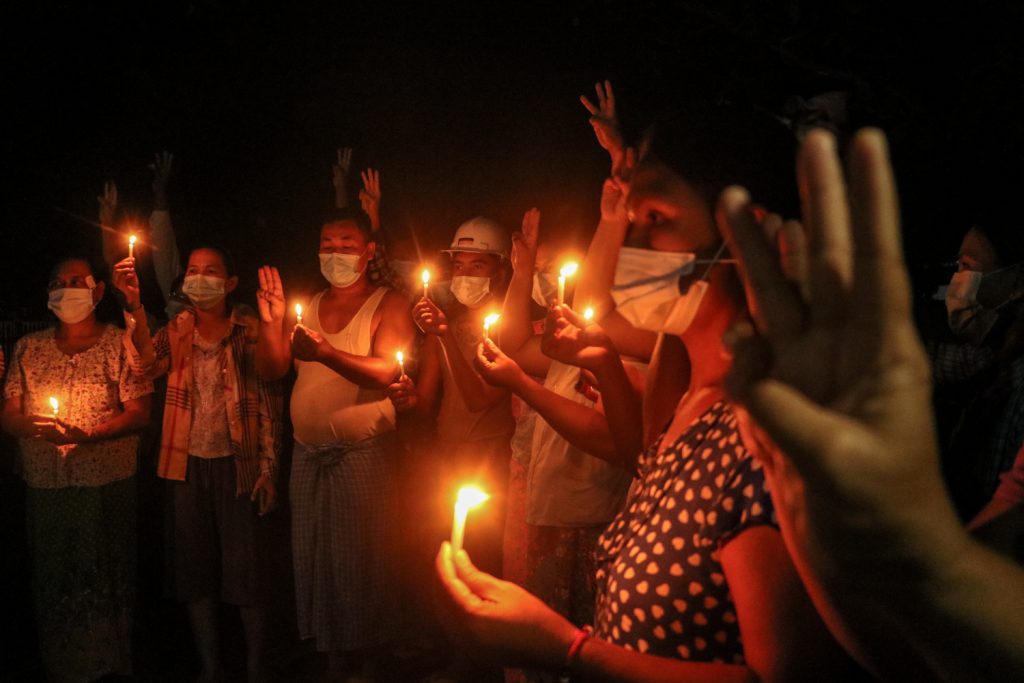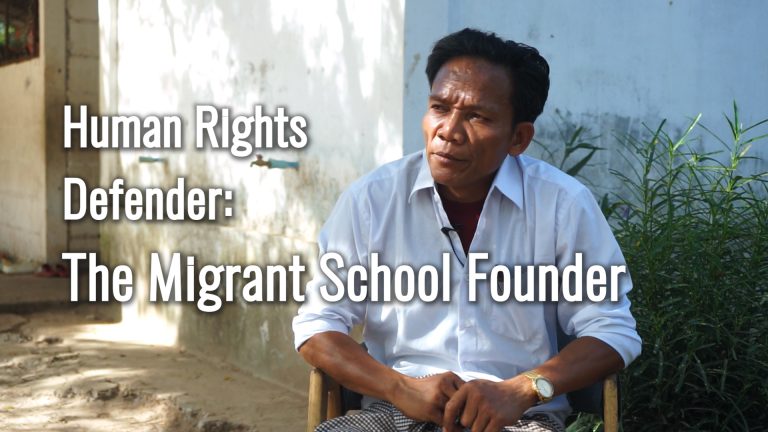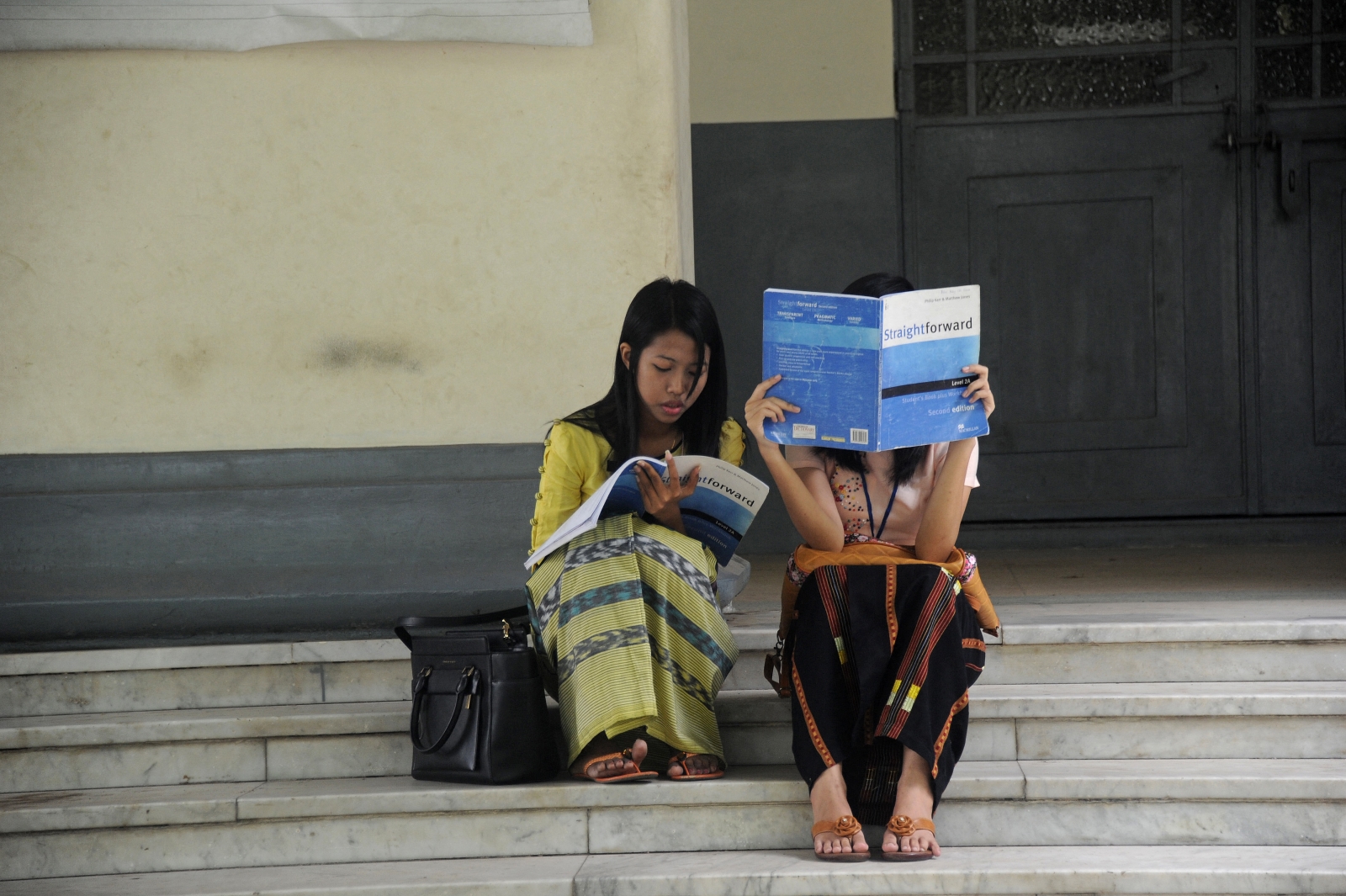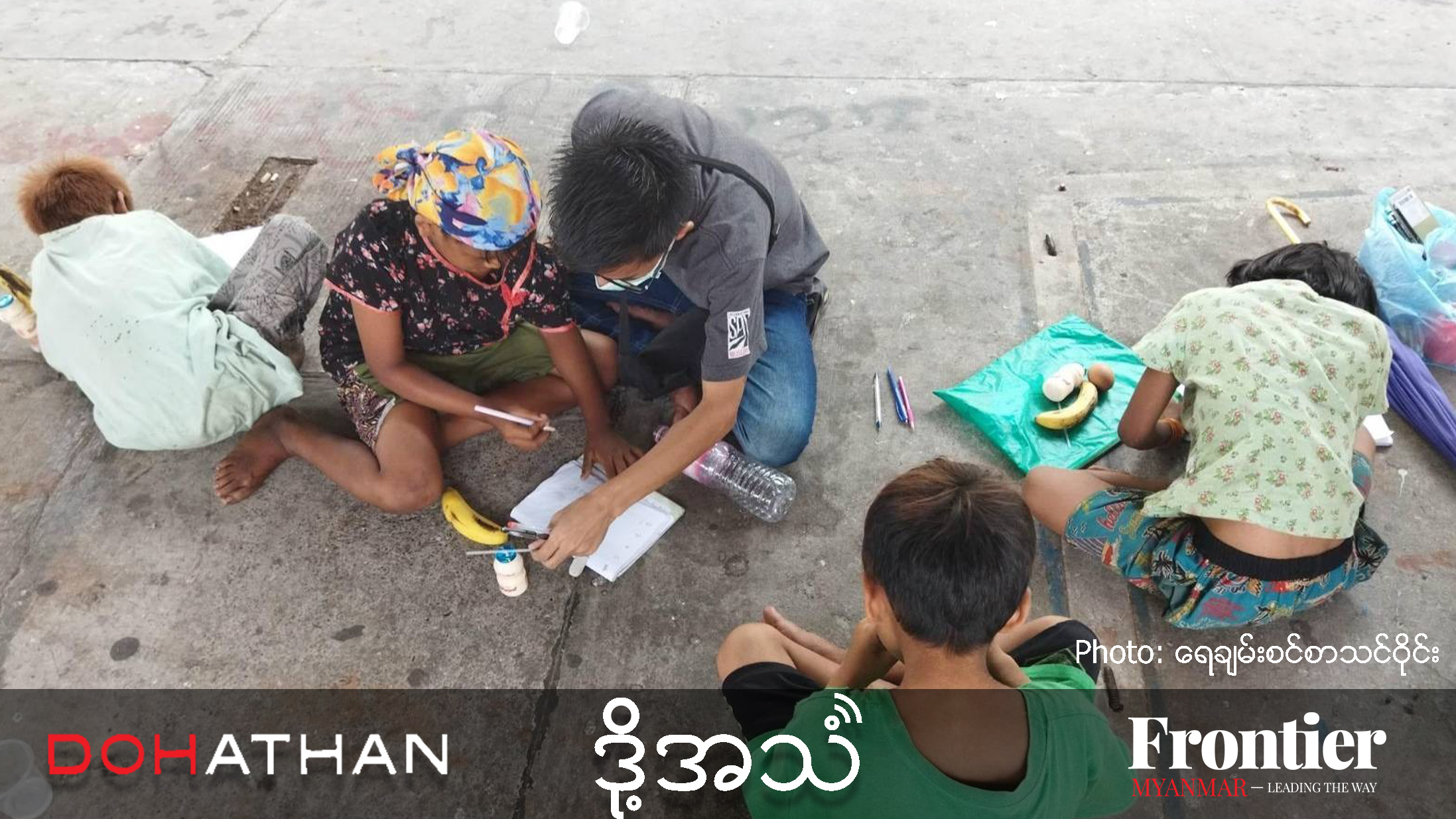Despite the dangers, protesters in the Sagaing Region capital say they will keep hitting the streets – to send a strong message to the people, the junta and the world, and to honour fallen comrades.
By FRONTIER
The 36-year-old private school teacher grimaced as she lowered herself to the floor of the safe house. It was one of many she had called home in recent months, since the security forces put out a warrant for her arrest.
The brace enclosing her waist hinted at her bruising escape from a crackdown in early April, when the security forces pummeled her with batons. If the teacher went to hospital, she risked arrest, so instead she met her family doctor in secret. Still, she considers herself lucky. “Some others weren’t able to get away that day,” said the teacher, who asked not to be named for security reasons.
Despite the near-constant pain, the teacher spoke with steely determination about the protest movement in her hometown of Monywa, the Sagaing Region capital, where teachers and students have led opposition to the Tatmadaw’s February 1 coup.
She insisted that the violent crackdowns since late February, including the shooting of unarmed protesters, have failed to subdue opposition to military rule.
“Some people think Monywa is getting quiet now, but they’re the ones who are doing nothing for the revolution – the ones who are at home, scrolling through their phones and reading news,” said the teacher, a mother of two children. “We keep doing as much as we can. There are now a lot of restrictions in Monywa that make it very hard for us to protest. But we understand that every part of this revolution needs to stay strong.”
Even as resistance has shifted to armed struggle, including in the Dry Zone countryside around Monywa, residents still organise near-daily protests against the regime. Today it one of the few major towns where demonstrations continue on a regular basis.
During a visit to Monywa in May, resistance leaders emphasised to Frontier the importance of maintaining street protests in tandem with the public sector strikes under the Civil Disobedience Movement, and alongside the work of the Committee Representing Pyidaungsu Hluttaw, a body formed by ousted lawmakers in February that has since appointed a parallel National Unity Government.
Because its protest movement has endured in the face of extreme violence, young resistance leaders proudly refer to their town as “sauk kyaw tin Monywa” (fucking stubborn Monywa).
On May 4, Frontier observed a flash protest in which more than 100 people converged from different areas onto a ward where the security presence was light. Scouts first observed the ward, including major roads, for signs of police or soldiers, and once they gave the all-clear the participants marched quickly through the streets, chanting slogans loudly to catch the attention of nearby residents. Many people emerged from their homes to clap or join the chanting, sometimes presenting energy drinks and water bottles to the marchers. The protest lasted less than 20 minutes, and afterwards the participants gathered briefly in a narrow residential street to listen to protest leaders.
“The street protests that triggered this Spring Revolution … have not disappeared yet,” Ko Than Kyaw Oo, the chair of Monywa University Students’ Union, told them.
“These protests are like a fist punch to the vulnerable sternum of the military council. It causes them a lot of trouble. However much they want to, they can’t control the town,” he said. “We will keep on protesting and our town will still be known as ‘fucking stubborn Monywa’.”
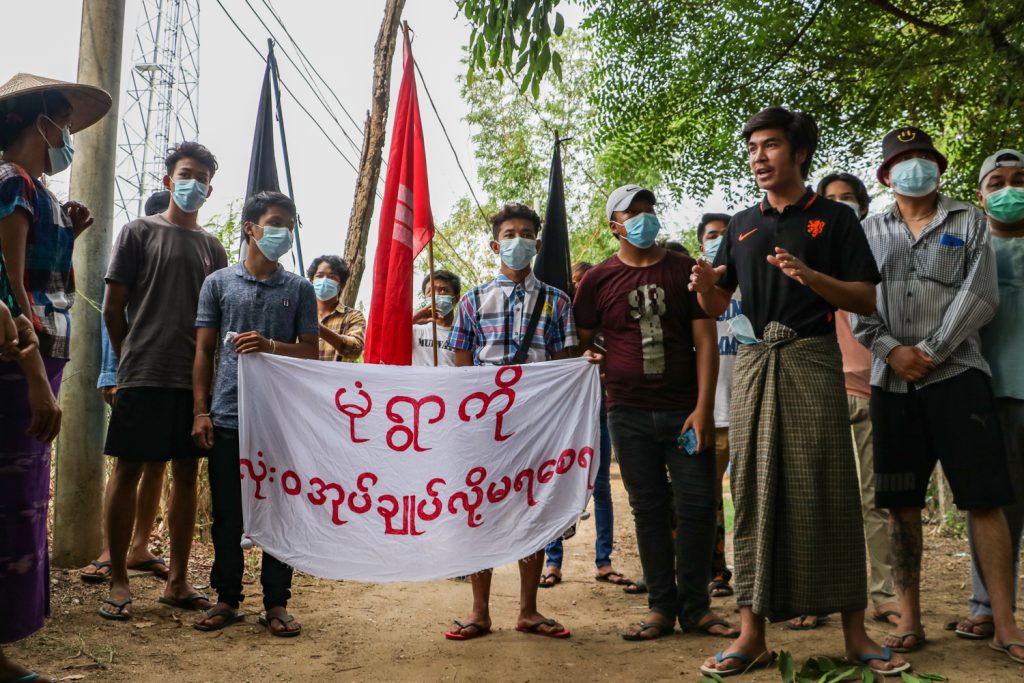
Everything ‘gone to waste’
On the day of the coup, teacher Daw Mya San Kywe was in Monywa helping to mark exam papers.
“I cried that day,” the 42-year-old mother of three told Frontier. “But I was also angry – so were many other people here in Monywa.”
She resolved to do whatever she could to oppose the military. On February 6, she and other teachers from her school, Basic Education High School Nyaung Phyu Pin, launched a photo campaign, posing in their green and white uniforms and giving the three-finger salute that quickly became a symbol of opposition to the regime. Two days later, 31 of the 45 teachers from the school took part in a protest.
Sources in Monywa estimate that around two-thirds of all teachers in the district, which includes three other townships besides Monywa, have gone on strike and joined the CDM, a relatively high rate.
NLD lawmaker U Myint Htwe, who won the Sagaing Region Hluttaw seat of Ye-U 2 in the November election, said local teachers had been invaluable in resisting military rule.
“We are all grateful and thankful for their efforts in this revolution,” he said.
Although Mya San Kywe no longer takes part in demonstrations, she remains active in the resistance movement, helping to raise and distribute donations for striking workers who have joined the CDM.
Mya San Kywe’s younger sister, Daw San San Lin, also teaches at a school in Monywa. They had both been optimistic about the future of education in Myanmar, particularly the prospects for further reform during the National League for Democracy’s second term, which was meant to start this year. They said they knew straight away that the military’s power grab had put paid to any chance of that. “It felt like everything we had been trying to achieve had gone to waste,” said Mya San Kywe.
When she got news of the coup, San San Lin was waiting for her husband-to-be to arrive in Monywa for their wedding, due two days later on February 3. The communications shutdown meant that she was unable to reach him for most of the day, and she wondered whether the ceremony would still go ahead.
Although they were able to marry as planned, the couple were in no mood to celebrate. From the following day, they dedicated themselves to the Spring Revolution, joining the CDM and participating in protests.
She said teacher strikes had helped to sustain opposition to the coup in multiple ways.
“The number of teachers in Myanmar is higher than the number of military personnel. That’s why I feel our CDM is as important as the others,” San San Lin said, referring to other public sector walkouts.
“Other government employees also don’t have contact with students like we do. So if teachers participate in the revolution then youths get more involved too. If a teacher is in danger or threatened with arrest, the students will stand by them.”
Despite their determination, San San Lwin and Mya San Kywe have both been shocked at the regime’s brutality, particularly towards young protesters. Figures from the Assistance Association for Political Prisoners show that security forces have killed 27 people and arrested 80 in Monywa from April 3 to June 7.
Mya San Kywe said she’s tired of the loss of life and hopes the Spring Revolution will succeed soon, so that fewer people have to die. “When I saw young people dead on the road, even though I didn’t know them personally, my heart was broken,” Mya San Kywe said, before adding with grim humour: “Even when my ex-husband left me to marry another woman, I wasn’t that sad.”
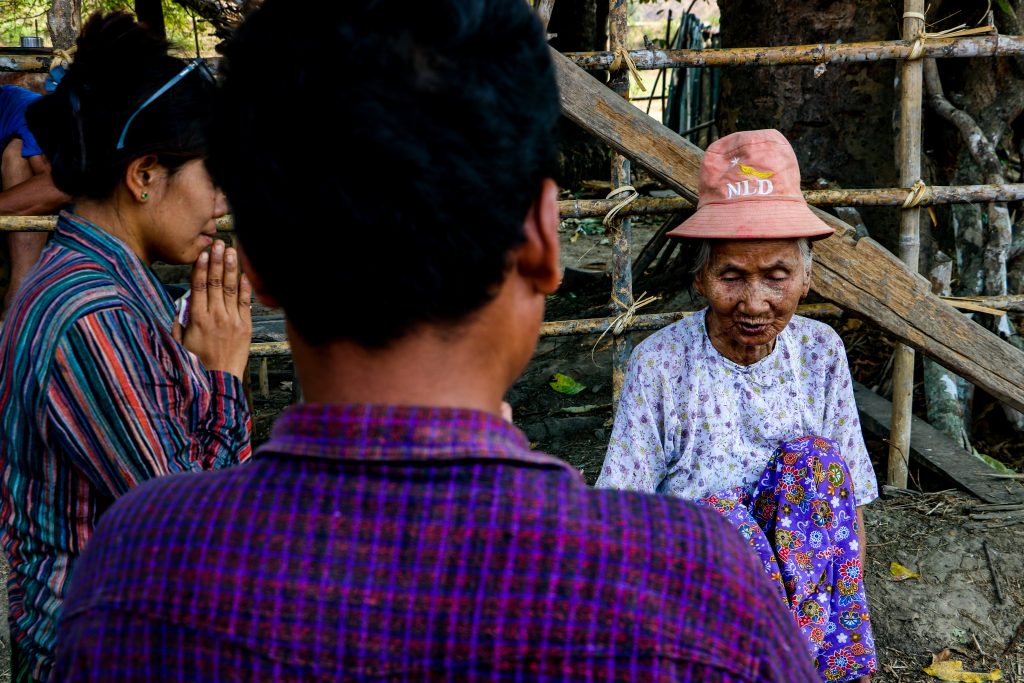
Fallen heroes
After several weeks of swelling protests in which tens of thousands of people marched through the streets of Monywa, the security forces launched their first major crackdown on February 27. About 200 people, mostly teachers and students, were surrounded by security forces near Zaung Kyan Bin monastery, in the middle of town.
At first security forces started shooting with teargas and stun grenades, but around 11am opened fire with live rounds. A restaurant owner was shot in his thigh and a teacher was shot in her abdomen but both survived, said U Myo Min Oo, a member of the Thumaydar volunteer organisation that has helped transport and treat those injured in the protests.
He said he was shocked at the violence, but it would soon get much worse. Just seven days later, he watched as police and soldiers opened fire on a protest organised by the town’s General Strike Committee.
“The protest group was taking a break in the afternoon at the corner of Aung Mahar and Pyidaungsu roads, near Hpayani Pagoda. The protesters had some food and then when they started moving to resume their march the security forces emerged and shot them immediately with live rounds,” said Myo Min Oo.
The nine fallen heroes that day included poet and educator Ma Myint Myint Zin, 34.
Better known to many by her penname, Kyi Lin Aye, she started writing poems and novellas in high school. After graduating with a degree in mathematics, she dedicated herself to education, volunteering as a teacher at monastic schools in the area.
She and her younger brother, Ko Win Min Latt, also co-founded a social welfare association, Myitta Dika, that funded teachers, books and meals for orphans and other children whose parents could not afford to send them to school.
Win Min Latt said that immediately after the coup, his sister began organising small protests in their neighbourhood, during which residents banged pots and pans, sung revolutionary songs and chanted slogans condemning the coup. “Even though she had never been involved with political parties or political movements before, she knew this the coup would be bad for the country,” he said.
From February 6, Myint Myint Zin began organising larger demonstrations, encouraging her friends and students to take part. “From that day until the day she died, she was involved [in the revolution],” Win Min Latt said.
Like many protesters, she knew the risks she was taking. On the day she was shot dead, she had written her blood type and her mother’s phone number on her arm with a marker, along with a message that her body was to be donated to Mandalay General Hospital.
Win Min Latt got the news about his sister just a few minutes after she was shot. Not long after, he learned she’d died in the ambulance on the way to the hospital.
“My heart felt totally empty,” he said. “She was such an amazing person, I just felt it was such a waste. We weren’t just siblings; we were great friends. So, I’ve lost not only a sister but also a friend.”
The next day, Monywa residents renamed Aung Mahar Road, where Myint Myint Zin and eight others had died, as Arzani (martyrs) Road.
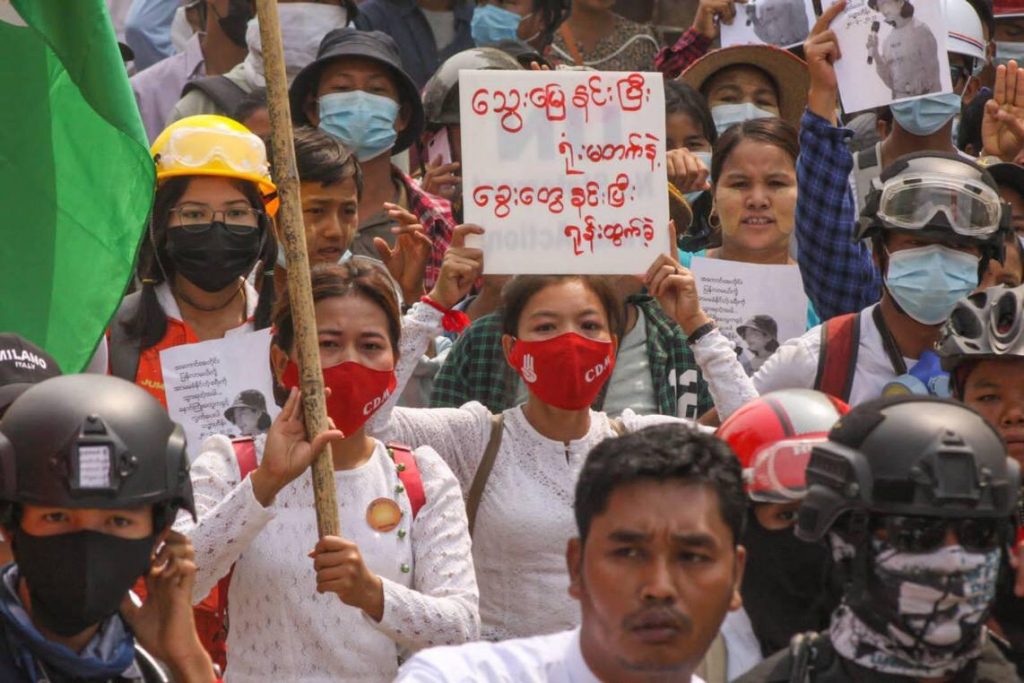
Honouring sacrifice
Students have also been integral to Monywa’s resistance movement; and as the security forces have grown more violent, they’ve also borne the brunt of the casualties.
“Some of our comrades have died in our arms,” said Ko Khant Wai Phyo, a student activist and leading member of the Monywa General Strike Committee. “We feel we’re responsible for sustaining the movement and making sure their hopes are fulfilled.”
Ko Aung Kyaw, another student activist who is also part of the strike committee, echoed his words. “Every revolution requires sacrifice, but we don’t want these sacrifices to be in vain,” he said. “We will keep on fighting until we achieve the goal these fallen heroes were striving for.”
Like the teachers, the students are committed to ensuring that protests continue in Monywa, despite the risks. They and other activists said this was important for a number of reasons: to show that the people still reject military rule, to maintain hope that the revolution will succeed, and to remind the world that the people of Myanmar are still under dictatorship.
To maintain the momentum, activists try to organise at least one protest a day. This can take the form of motorcycle rallies in areas of Monywa town with a light security presence, but when there are too many soldiers or police in the town, they demonstrate in nearby villages instead.
Teacher Ma Soe Myint Htwe, who had to flee with her family into a forest when clashes erupted between a civilian militia and the Tatmadaw, said she would “stay with the CDM until the dictators fall”.
“There’s no way I can work under them,” said the 24-year-old, who had shelved plans to pursue a master’s degree in order to join local protests. “I want them to be annihilated as soon as possible – the longer they’re in power, the more likely we are to return to the dark days of the past.”


